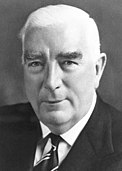Australian federal election, 1963
|
|
||||||||||||||||||||||||||||||||||
|---|---|---|---|---|---|---|---|---|---|---|---|---|---|---|---|---|---|---|---|---|---|---|---|---|---|---|---|---|---|---|---|---|---|---|
|
||||||||||||||||||||||||||||||||||
|
All 122 seats of the Australian House of Representatives 62 seats were needed for a majority |
||||||||||||||||||||||||||||||||||
|
||||||||||||||||||||||||||||||||||
|
||||||||||||||||||||||||||||||||||
Robert Menzies
Liberal/Country coalition
Robert Menzies
Liberal/Country coalition
Federal elections were held in Australia on 30 November 1963. All 122 seats in the House of Representatives were up for election. The incumbent Liberal Party of Australia led by Prime Minister of Australia Robert Menzies with coalition partner the Country Party led by John McEwen defeated the Australian Labor Party led by Arthur Calwell.
See Australian federal election, 1961 and Australian Senate election, 1964 for Senate compositions.
The election was held following the early dissolution of the House of Representatives. The Prime Minister of Australia, Robert Menzies, gave as his reason for calling an election within two years that there was an insufficient working majority in the House. The 1961 election had been won with a substantially reduced majority of only two seats. One of the consequences of an early House election was that there were separate Senate and House elections until 1974. This became a factor in the Gair Affair.
...
Wikipedia


